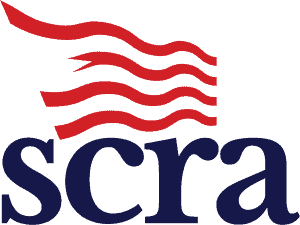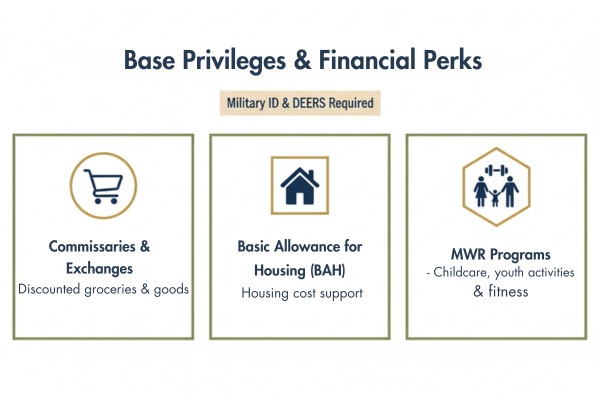Military Spouse Benefits: What You Need to Know

Life as part of a military family is never ordinary. One month, you might be setting up a new home across the country, the next, you could be managing long stretches apart while your partner serves on active duty. These constant shifts bring challenges, yet they also unlock benefits that can ease the weight of military life.
What many spouses do not realize is that these benefits are not automatic. Most military spouse benefits require careful applications, enrollment in systems like DEERS, or filings with Veterans Affairs. Factors such as a service member’s status, years of marriage, or even events like a service member’s death can affect what support you qualify for.
This guide will highlight the opportunities available, from education aid to survivor programs, and explain how to make the most of them. The answers you are looking for may be closer than you think.
Contents
- 1 1. Education Support and Scholarships for Military Spouses
- 2 2. Healthcare and Medical Benefits
- 3 3. Survivor and Death Benefits for Military Spouses
- 4 4. Base Privileges and Financial Perks
- 5 5. Career and Remote Job Support Programs
- 6 6. Family and Emotional Support Services
- 7 7. How to Apply for Military Spouse Benefits
- 8 8. How Long Must a Spouse Be Married to Qualify for Benefits?
- 9 9. Entrepreneurship and Business Start-Up Support
- 10 10. Recognition, Policy Expansion & Advocacy in 2025
- 11 What Benefits Are Available to Spouses After the Death of a Service Member?
- 12 Need to Prove Military Status for Benefit Applications?
- 13 FAQs
- 13.1 What military education programs are available to surviving spouses?
- 13.2 Can I receive TRICARE benefits after divorcing a military member?
- 13.3 What happens to my benefits if I remarry?
- 13.4 Is the MyCAA scholarship still active in 2025?
- 13.5 What documents do I need to enroll in DEERS for the first time?
- 13.6 Can I get reimbursed for a business license after moving?
1. Education Support and Scholarships for Military Spouses
Education is one of the most impactful benefits for military spouses, especially when frequent moves make it difficult to build a steady career. Several programs exist to reduce out-of-pocket expenses and open new opportunities.
MyCAA (My Career Advancement Account)
The MyCAA program provides up to $4,000 in tuition assistance, capped at $2,000 per year. This funding can be used for associate degrees, certifications, or licenses that lead to portable career fields such as teaching, healthcare, or information technology.
To qualify, you must be the spouse of an active duty service member ranked E-1 through E-5, W-1 through W-2, or O-1 through O-2 under Title 10 orders.
Applications are submitted through Military OneSource, where you create an account and outline a career plan before funds are approved. This program helps military spouses save money while preparing for careers that can travel with them during relocations.
Fry Scholarship (Chapter 33)
For surviving spouses, the John David Fry Scholarship offers up to 36 months of Post 9/11 GI Bill-style education benefits. These include tuition, housing support, and book allowances.
Eligibility is extended to spouses of service members who died in the line of duty after September 10, 2001, or from a service-connected disability. Benefits do not expire unless you remarry, and you may also be eligible to receive Dependency and Indemnity Compensation at the same time.
For example, a surviving spouse can pursue a business degree or nursing program without the burden of financial barriers.
SECO (Spouse Education and Career Opportunities)
SECO goes beyond tuition by offering career development support. Through this program, you gain access to career counseling, resume building, and job search tools.
SECO also connects you with scholarships, fellowships, and training programs that fit into the unique challenges of military life. A spouse who often relocates might use SECO resources to pursue a portable career field, ensuring stability no matter where military service takes the family.
2. Healthcare and Medical Benefits
Medical coverage is one of the most important benefits for military spouses, helping families manage care without overwhelming out of pocket expenses. Programs like TRICARE, CHAMPVA, and DEERS form the foundation of this support.
TRICARE for Active Duty Spouses
Spouses of active duty service members qualify for TRICARE, which provides access to Prime or Select plans. Both options cover medical, dental through FEDVIP, and vision care. Enrollment in DEERS, along with a valid Uniformed Services ID card, is required to use these benefits.
TRICARE Prime typically has lower costs but requires care from network providers, while TRICARE Select offers more flexibility with slightly higher costs. In 2025, the catastrophic cap for Group A active duty family members enrolled in TRICARE Prime is $1,000, helping families manage annual out-of-pocket costs.
CHAMPVA for Surviving Spouses
Surviving spouses may be eligible for CHAMPVA if the veteran was permanently and totally disabled from a service connected condition or died from service related causes. This coverage helps ensure that health care continues even after a service member’s death.
Access to CHAMPVA can change with remarriage or if Veterans Affairs adjusts disability status, making it important to review eligibility details over time.
DEERS Enrollment
DEERS is the system that verifies eligibility for uniformed services benefits. Without proper enrollment, access to TRICARE or CHAMPVA may be delayed or denied. Keeping DEERS records updated ensures smooth access to prescriptions, referrals, and treatment at military treatment facilities for both spouses and dependent children.
3. Survivor and Death Benefits for Military Spouses
Losing a service member is a reality that changes everything for a family. Survivor benefits are designed to provide financial assistance and stability for military spouses facing this difficult chapter.
Two key programs are Dependency and Indemnity Compensation and the Survivor Benefit Plan.
Dependency and Indemnity Compensation (DIC)
Dependency and Indemnity Compensation is a monthly tax free payment available if a service member dies on active duty or from service connected disabilities.
As of 2025, surviving spouses can now receive both DIC and SBP in full, with no offset. While VA disability benefits do not transfer directly, DIC helps fill the gap with steady financial support.
How to File for DIC via VA.gov:
- Visit the VA’s official DIC benefits page.
- Verify eligibility as a surviving spouse, dependent, or parent of a deceased veteran.
- Prepare documents such as:
- Veteran’s discharge papers (DD214)
- Death certificate
- Marriage certificate
- Medical evidence related to service-connected conditions
- Submit VA Form 21P-534EZ online at VA.gov, or mail it to your state’s VA pension management center.
- Upload legible copies of all records to speed up processing.
- Monitor application status through your VA.gov account or call 1-800-827-1000 for updates.
Survivor Benefit Plan (SBP)
The Survivor Benefit Plan is an annuity that provides 55 percent of a service member’s retired pay to their surviving spouse. Payments last for life unless the spouse remarries before age 55. For deaths during active duty, SBP is calculated using the disability retirement formula.
How to Verify SBP through DFAS:
- Go to the DFAS SBP management page.
- Complete an annual eligibility verification, due on the first day of the month of your birthday.
- Submit the appropriate verification form:
- Marital status update
- School certification (Form DD 2788 plus attendance letter) for children ages 18–22
- Foreign address update for overseas annuitants
- Submit forms by mail, fax, or online via askDFAS.
- Keep mailing addresses and payment details current to avoid missed payments.
- Payment options include Pay.gov, VA disability compensation deductions, or Federal Treasury payment portals.
- Contact DFAS at 1-800-321-1080 for questions or changes.
4. Base Privileges and Financial Perks
Military life may bring constant change, but it also offers financial perks and everyday privileges that help families save money and find support.
With a valid military ID and DEERS enrollment, spouses can access valuable services that improve quality of life.
- Commissaries and Exchanges: Spouses can shop for groceries and household items at discounted rates, often cutting costs compared to civilian stores.
- Basic Allowance for Housing (BAH): This allowance helps cover family housing expenses, whether you live on base or in nearby communities, giving families financial stability despite frequent moves.
- Morale, Welfare, and Recreation (MWR): MWR programs provide childcare support, after-school care, summer programs for school-age children, sports leagues, and recreational activities, including access to golf courses and fitness centers.
Access to these benefits depends on the service member’s status, whether active duty or retired. Surviving spouses may retain certain privileges if they remain unmarried, although eligibility can differ by program.
5. Career and Remote Job Support Programs
Building a career while balancing military life is no small task. Frequent relocations, licensing requirements, and gaps in employment often stand in the way.
To help overcome these challenges, multiple programs now support military spouses with job opportunities, financial assistance, and skill-building tools.
Military Spouse Employment Partnership (MSEP)
MSEP is part of the Spouse Education and Career Opportunities program and connects spouses to a network of more than 950 employers who actively recruit and retain military spouses.
This initiative also includes a free one-year membership with FlexJobs, making it easier to find remote work that fits around deployments or frequent moves.
Licensing Reimbursements
When a PCS move disrupts your career, licensing reimbursement helps cover the cost of starting over. Military spouses can claim up to one thousand dollars for expenses related to certifications, licenses, or business fees.
Claims are submitted with documentation through each branch’s personnel office, ensuring spouses can quickly get back to work without shouldering heavy out-of-pocket costs.
Career Accelerator Pilot
The Department of Defense launched the Military Spouse Career Accelerator Pilot to strengthen career continuity. This program offers twelve-week paid fellowships at no cost to employers, giving military spouses hands-on experience and helping them stand out in competitive fields.
In addition, eligible spouses can receive a free year of LinkedIn Premium and LinkedIn Learning, opening access to professional development, recruiter connections, and career counseling resources.
6. Family and Emotional Support Services
Behind every service member is a family carrying its own share of stress. From managing long deployments to settling into a new community after relocation, military spouses often shoulder unique challenges.
To provide support, several programs are available that focus on counseling, childcare, and everyday guidance.
Military OneSource
Military OneSource is a cornerstone of family support. Available 24/7, it offers confidential counseling, financial planning, and parenting resources tailored to military families. Spouses can use it to get help during major transitions such as deployment returns or cross-country moves.
The service also connects users to SECO for career advice, child care referrals, and even legal assistance when questions arise. You can explore its many resources through the Military OneSource locator.
Child Care Assistance
Childcare is one of the biggest concerns for military families, especially during deployments or training. The Department of Defense helps reduce this burden through subsidies, referrals, and pilot programs that make quality care more affordable.
Availability depends on your service branch, location, and DEERS enrollment status. To find options close to you, the DoD Child Development Center locator provides information on facilities available on or near military bases.
7. How to Apply for Military Spouse Benefits
Knowing about benefits is one thing, but the real challenge is navigating the application process. Many military spouses miss out simply because they do not complete enrollment on time or submit the right documents.
Following the right steps early helps you avoid delays and ensures your family support begins without interruptions.
Step 1: Enroll in DEERS
Every benefit starts with DEERS. To complete enrollment, you will need:
- Marriage certificate
- Spouse’s birth certificate
- Social Security number
- Photo identification
Enrollment is done at a RAPIDS or ID Card Office, or you can begin online through the ID Card Office Online portal. Without DEERS, programs like TRICARE, BAH, or commissary access cannot be activated.
Step 2: Apply for Health, Housing, and Financial Programs
Once DEERS is complete, you can apply for key benefits:
- TRICARE: Select a plan within 90 days to ensure uninterrupted health care coverage.
- Housing: Apply for base housing through your installation or opt for Basic Allowance for Housing if you live off base.
- Financial Programs: Explore options such as childcare subsidies or counseling services available through Military OneSource.
Step 3: Apply for Education Benefits
If you are pursuing education, start with the right program:
- MyCAA: Create an account and submit an education plan before enrolling in courses.
- VA Education Programs (Fry Scholarship, GI Bill): Apply through VA.gov with service records and supporting documentation.
Step 4: Survivor Benefits (if applicable)
Widowed spouses may apply for Dependency and Indemnity Compensation (DIC) through VA.gov and verify Survivor Benefit Plan (SBP) eligibility through DFAS. Remember to update marital status if you remarry, as this can affect eligibility.
8. How Long Must a Spouse Be Married to Qualify for Benefits?
One of the most common questions asked is how long a spouse must be married to qualify for military benefits. The answer depends on the type of benefit and the circumstances, but enrolling in DEERS is always the first step.
Most benefits for military spouses begin as soon as the marriage is recognized and DEERS registration is complete. This allows access to health care, commissary privileges, and housing allowances almost right away.
For VA benefits, certain requirements apply:
- Dependency and Indemnity Compensation (DIC): Generally requires at least one year of marriage, unless there is a child from the marriage.
- Survivor Benefits (SBP or DIC): Remarriage before age 55 may end eligibility.
Divorced spouses follow different rules known as 20/20/20 and 20/20/15:
- 20/20/20 rule: 20 years of marriage, 20 years of creditable service, with full overlap, gives lifetime access to benefits.
- 20/20/15 rule: 20 years of marriage, 20 years of service, but only 15 years overlap gives one year of transitional coverage.
These timelines make it important for spouses to confirm their eligibility early and understand how marriage length, divorce, or remarriage may affect continued access to benefits.
9. Entrepreneurship and Business Start-Up Support
Starting over after every relocation can be frustrating, especially for military spouses who run small businesses or hold professional licenses. To ease that burden, the Department of Defense offers reimbursement programs that help keep careers and income steady after a PCS move.
Spouses can receive up to $1,000 in reimbursements for expenses tied to transferring professional licenses or covering business costs in a new state. This support applies across most military branches and requires proof of PCS orders along with receipts for the costs incurred.
Covered expenses may include:
- State certification or license renewal in a new location
- Legal fees for creating or transferring a business entity
- Professional registration costs disrupted by relocation
Applications are managed through each service branch’s personnel office or with guidance from Military OneSource. For many spouses, this benefit provides continuity of income, making it possible to maintain a freelance career or professional practice even when military life demands frequent moves.
10. Recognition, Policy Expansion & Advocacy in 2025
Military spouses are often described as the unsung heroes of military life, and recent years have seen growing recognition of their sacrifices. Each year, the White House declares Military Spouse Day, a reminder of the resilience and contributions of nearly one million spouses who balance family, career, and service commitments.
In 2025, the Department of Defense will focus even more on retaining military spouses through new initiatives. The Military Spouse Career Accelerator Pilot now offers fully funded twelve-week fellowships, giving spouses valuable workplace experience without added cost to employers.
Combined with the expansion of SECO, these efforts are designed to create stronger pathways for career growth and stability.
Policy changes are also addressing long-standing obstacles. The DoD is actively working with employers to improve licensing portability across states and to expand remote job opportunities. These changes are more than symbolic; they provide real solutions for spouses whose careers are often disrupted by relocation.
Together, these advocacy efforts and policy expansions reflect a lasting commitment to making military spouse benefits more accessible, practical, and supportive in the years ahead.
What Benefits Are Available to Spouses After the Death of a Service Member?
The loss of a service member brings not only emotional pain but also sudden financial and practical challenges. To provide stability, several programs exist to support surviving spouses with ongoing income, health care, and education opportunities.
These military death benefits for spouses ensure that families are not left without resources during such a difficult time.
Key benefits include:
- Dependency and Indemnity Compensation (DIC): A monthly tax-free payment from the VA for surviving spouses if the service member died on active duty or from a service-connected disability. As of 2025, DIC can be received in full alongside SBP, removing the long-standing offset.
- Survivor Benefit Plan (SBP): A retirement-style annuity paying 55 percent of the service member’s retired pay. Payments last for life unless remarriage occurs before age 55.
- CHAMPVA: Health care coverage for surviving spouses who are not eligible for TRICARE. This program helps reduce out-of-pocket medical costs.
- Education Benefits: The Fry Scholarship provides up to 36 months of Post 9/11 GI Bill-style benefits for education and housing, while Dependents’ Educational Assistance (DEA) supports training and schooling for eligible spouses.
While VA disability benefits do not transfer directly to surviving spouses, DIC often serves a similar role by offering steady financial assistance. These programs together help cover medical care, tuition, and living costs, giving surviving families the tools to move forward while honoring the service member’s sacrifice.
Need to Prove Military Status for Benefit Applications?
Many military spouse benefits, from TRICARE coverage to MyCAA tuition support to survivor programs like DIC and SBP, begin with one common step: proving your spouse’s military status. Without this verification, even the most straightforward applications can be delayed or denied.
That’s where SCRACVS steps in. Using official Department of Defense sources, we provide fast and secure verification of active duty status. Our service is trusted by law firms, lenders, and government professionals nationwide, giving you confidence that your paperwork is accurate and accepted the first time.
Think of it as removing the last obstacle between you and the benefits you’ve just learned about. With verification in hand, you can focus on what matters most, making full use of the programs designed to support military families.
Start your verification here and take the next step with confidence.
FAQs
What military education programs are available to surviving spouses?
Surviving spouses may qualify for several education benefits designed to reduce financial barriers and provide career opportunities. The Fry Scholarship offers up to thirty-six months of post-9/11 GI Bill-style support, covering tuition, housing, and books. Dependents’ Educational Assistance, or DEA, provides additional financial aid for training and school programs. Together, these benefits for military spouses help cover tuition costs, support professional development, and give eligible surviving spouses the chance to pursue degrees or certifications that provide long-term stability.
Can I receive TRICARE benefits after divorcing a military member?
Divorced spouses may retain certain benefits depending on the length of marriage and service overlap. Under the 20/20/20 rule, a former spouse who was married for at least twenty years, with twenty years of creditable service and full overlap, may continue TRICARE health care coverage. Those who meet the 20/20/15 rule can access transitional benefits for one year. Beyond these categories, TRICARE access typically ends after divorce, although some former spouses may qualify for CHCBP, a separate health care option with costs.
What happens to my benefits if I remarry?
Remarriage can affect eligibility for several military benefits. For example, surviving spouses receiving Dependency and Indemnity Compensation or payments under the Survivor Benefit Plan may lose eligibility if they remarry before age fifty-five. Commissary access, exchange privileges, and certain health care programs may also end with remarriage. If the marriage later ends in divorce or the new spouse passes away, some benefits can be restored. Because rules differ across programs, surviving spouses should always verify their status with DFAS, Veterans Affairs, or the appropriate branch office.
Is the MyCAA scholarship still active in 2025?
Yes, the My Career Advancement Account, or MyCAA, continues to support education for military spouses in 2025. This program provides up to four thousand dollars in tuition assistance, capped at two thousand dollars per year, to cover associate degrees, certifications, or licenses in portable career fields. Eligible spouses of active duty service members in specific ranks can apply through Military OneSource by creating an account and submitting a career plan. MyCAA helps military spouses save money on tuition while preparing for stable careers despite frequent relocations.
What documents do I need to enroll in DEERS for the first time?
To enroll in DEERS and begin accessing benefits for military spouses, you must provide several key documents. These include a marriage certificate, the spouse’s birth certificate, Social Security number, and a valid photo ID. Enrollment is completed at a RAPIDS or ID Card Office, where a Uniformed Services ID card is issued after approval. Without DEERS, spouses cannot access TRICARE, Basic Allowance for Housing, commissary privileges, or other family support programs. Ensuring documents are accurate and up to date avoids delays in health care and financial assistance.
Can I get reimbursed for a business license after moving?
Yes, military spouses can be reimbursed for professional licensing or business-related costs after a PCS move. The Department of Defense allows up to one thousand dollars in reimbursement for state certification, license renewals, or business entity fees disrupted by relocation. Proof of PCS orders and itemized receipts must be submitted to your branch’s personnel office. This benefit helps reduce expenses and encourages continuity of income, especially for freelance professionals and spouses in portable career fields who often face financial barriers after moving.







